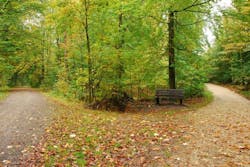The first visitor center we designed was the Ernest F. Coe Visitor Center for the Everglades National Park in 1993.
I remember it well for a variety of reasons, not the least of which was the ongoing dialogue we had with our retail consultant. He insisted that the gift shop be located on the right as one exited the visitor center because people “always turn right.”
The idea that the gift shop was located near the exit made perfect sense—one last chance to entice visitors to open their wallets. But I wasn’t convinced that it must be on the right.
My feeling was that if you have a clear destination, one will gravitate toward it regardless of whether it is on the right or left. Now, I know there are probably many of you out there right now yelling at your computer screens, because, as I’ve come to learn, it is a commonly held belief, especially in the interpretive community, that one does indeed intuitively turn right. However, commonly held beliefs aside, I have never seen any solid research that supports the premise that we instinctively (ie: all things being equal) turn right.
More Recent Posts from GWWO
Seen and Overheard at the Port
Ironically, I was discussing this phenomena with our friends from Taylor Studios Inc. a few years ago at a National Interpreters Workshop, when they mentioned that they had conducted an informal study on the subject. As I recall, they were doing a public presentation and deliberately placed the information table on the left as one entered the lecture hall, to see if people would turn left given a clear destination.
However, the majority of the people turned to the right. I thought this was interesting, but still wasn’t convinced – maybe those who turned right were just avoiding solicitation and it had nothing to do with instinct. However, our conversation did prompt me to do some additional research.
One of the best articles I found was authored by Stephen Bitgood and Stephany Dukes, published in Environment and Behavior in 2005. Their findings indicated that movement is dictated by the environment and economy of movement. I maintained my belief that the tendency to turn right was not intuitive.
That is, until last summer…
My family takes a vacation every summer and we share a rental house with my wife’s sister and her family. Since there are usually 10 or 12 of us, the house we rent is typically fairly large. Last summer’s affair had a grand stair with a large landing that overlooked the foyer. As you walked up the stair, you had to turn left to go up to the second level. I swear, every time I went up that stair, I turned to the right onto the dead-end landing – I always turned right!
Since last summer, I have thought a lot about this subject. As Bitgood and Dukes pointed out, virtually every grocery store, as well as many other retail establishments, direct you to the right as you enter. We walk on the right in the United States, so maybe we just tend to stay to the right – I wonder if they tend to turn left in England?
We have designed many visitor centers and interpretive centers since 1993 and I have maintained my belief that movement is influenced by the environment and that we can shape experiences, rather than rely on the idea that we have an innate desire to turn to the right.
What do you think? Is it learned or instinct? Is this your experience? Is there any solid research on this subject? I would love to hear your thoughts and experiences.
About the Author
Alan E. Reed, FAIA, LEED AP, is President and Design Principal of GWWO Inc./Architects. See more posts by Reed.
About the Author
GWWO
At GWWO, we are architects, thinkers, wonderers, creators, partners, collaborators, debaters, and questioners. It is in this spirit—and based on our desire to engage, share, and discuss—that we blog. Our intent is to bring you news from the industry and our cultural and educational markets, to discuss our point of view, to pose thought-provoking questions, and to engage in discussion with our readers. We invite your suggestions, questions, and comments and look forward to an open and lively dialogue. Visit our blog site, and follow us on Facebook and LinkedIn.
